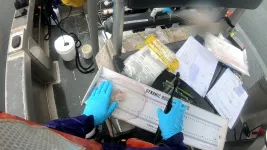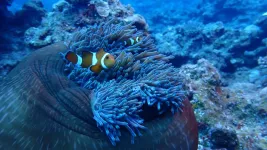(Press-News.org)
ALBUQUERQUE, N.M. — In a major breakthrough in the fields of nanophotonics and ultrafast optics, a Sandia National Laboratories research team has demonstrated the ability to dynamically steer light pulses from conventional, so-called incoherent light sources.
This ability to control light using a semiconductor device could allow low-power, relatively inexpensive sources like LEDs or flashlight bulbs to replace more powerful laser beams in new technologies such as holograms, remote sensing, self-driving cars and high-speed communication.
“What we’ve done is show that steering a beam of incoherent light can be done,” said Prasad Iyer, Sandia scientist and lead author of the research, which was reported in the current issue of the journal Nature Photonics. The work was funded by the Department of Energy’s Office of Science.
Incoherent light is emitted by many common sources, such as an old-fashioned incandescent light bulb or an LED bulb. This light is called incoherent since the photons are emitted with different wavelengths and in a random fashion. A beam of light from a laser, however, does not spread and diffuse because the photons have the same frequency and phase and is thus called coherent light.
In the team’s research, they manipulated incoherent light by using artificially structured materials called metasurfaces, made from tiny building blocks of semiconductors called meta-atoms that can be designed to reflect light very efficiently. Although metasurfaces had previously shown promise for creating devices that could steer light rays to arbitrary angles, they also presented a challenge because they had only been designed for coherent light sources. Ideally, one would want a semiconductor device that can emit light like an LED, steer the light emission to a set angle by applying a control voltage and shift the steering angle at the fastest speed possible.
The researchers started with a semiconductor metasurface that had embedded tiny light sources called quantum dots. By using a control optical pulse, they were able to change, or reconfigure, the way the surface reflected light and steer the light waves emitted from the quantum dots in different directions over a 70-degree range for less than a trillionth-of-a-second, marking a significant success. Similar to laser-based steering, the steered beam restrained the tendency of incoherent light to spread over a wider viewing angle and instead produced bright light at a distance.
Taming light
A feat previously considered impossible, the team’s proof-of-principle work paves the way for developments in the fields of nanophotonics and ultrafast optics. The ability to dynamically control incoherent light sources and manipulate their properties offers a wide range of applications.
One low-power use would be to brighten military helmet screens used to overlay maps or blueprints over ordinary vision. “In applications where space is valuable,” Iyer said, “steering light emission with low-size-and-weight metasurface-LED displays could be made possible in the future with this technology. We can use the light emitted in a better way rather than just turning them off and on.”
The technique could also provide a new kind of small display that can project holographic images onto eyeballs using low-power LEDs, a capability of particular interest for augmented and virtual reality devices. Other uses could be in self-driving cars where LIDAR is used to sense objects in the path of the car.
In terms of expressions of interest, the team has had several inquiries from commercial sources, said Sandia researcher Igal Brener, a paper author and lead scientist on the project. “A commercial product could be 5-10 years out, especially if we want to have all the functionality on-chip,” Brener said. “You wouldn’t use a control optical pulse to impart the changes in the metasurface needed to steer the light, but rather you would do this control electrically. We have ideas and plans, but it’s still early. Imagine an LED light bulb that can emit light to follow you. Then you wouldn’t waste all that illumination where there’s nobody. This is one of the many applications that we dreamed about with DOE years ago for energy efficiency for office lighting, for example.”
Similarly, tamed light may one day offer benefits in scenarios where focused illumination is only needed in a specific area of interest, such as surgery or in autonomous vehicles.
For incoherent light, the future is looking bright.
Sandia National Laboratories is a multimission laboratory operated by National Technology and Engineering Solutions of Sandia LLC, a wholly owned subsidiary of Honeywell International Inc., for the U.S. Department of Energy’s National Nuclear Security Administration. Sandia Labs has major research and development responsibilities in nuclear deterrence, global security, defense, energy technologies and economic competitiveness, with main facilities in Albuquerque, New Mexico, and Livermore, California.
END
How fresh are your data? For drones searching a disaster zone or robots inspecting a building, working with the freshest data is key to locating a survivor or reporting a potential hazard. But when multiple robots simultaneously relay time-sensitive information over a wireless network, a traffic jam of data can ensue. Any information that gets through is too stale to consider as a useful, real-time report.
Now, MIT engineers may have a solution. They’ve developed a method to tailor any wireless network to handle a high load of time-sensitive data coming from multiple sources. Their new approach, ...
The human body is made up of thousands of tiny lymphatic vessels that ferry white blood cells and proteins around the body, like a superhighway of the immune system. It’s remarkably efficient, but if damaged from injury or cancer treatment, the whole system starts to fail. The resulting fluid retention and swelling, called lymphedema, isn’t just uncomfortable — it’s also irreversible.
When lymphatic vessels fail, typically their ability to pump out the fluid is compromised. Georgia Institute of Technology researchers have developed a new treatment using nanoparticles that can repair lymphatic vessel pumping. Traditionally, ...
The Chicago Quantum Exchange (CQE) continued to expand its diverse community of quantum researchers, leaders, and institutions in 2022—launching a quantum research fellowship for undergraduates, welcoming 11 new corporate partners, and extending a regional quantum communication network to a total length of 124 miles.
These are among the successes highlighted in the CQE’s newly published annual report, which chronicles the many contributions of the consortium’s members and partners and offers a window into the region’s ...
Drifting along in ocean currents, jellyfish can be both predator and prey. They eat almost anything they can capture, and follow the typical oceanic pattern of large eats small. Now a recent University of British Columbia study on these gelatinous globs suggests jellyfish may get more nutritious as they get bigger.
As jellyfish grow, their size changes largely due to the chances of prey encounter, the length and number of tentacles, and their bells (the umbrella-like part of them). As a result, smaller jellyfish eat phytoplankton, microzooplankton, and eggs, while larger jellyfish can eat all of that plus shrimp and even fish. However, ...
An international research team led by the Netherlands Institute of Ecology (NIOO-KNAW) is to search for invisible life in the Galápagos Islands. The diversity of bacteria and other microscopic organisms may not be evident to the naked eye, but it is essential to nature. To the islands' giant daisies, for instance: unique endemic plants that are currently under threat.
How unique and diverse is the invisible microbial life of the iconic Galápagos Islands? That's what the Galápagos Microbiome Project - a group of scientists from the Netherlands, ...
Future ocean warming and marine heatwaves could impact the growth and development of clownfish during their earliest life stages, suggests a new study recently published in the journal, Science of The Total Environment.
A team of marine biologists from the Okinawa Institute of Science and Technology (OIST) reared the iconic coral reef fish in captivity at water temperatures of either 28°C or 31°C. Temperatures of 28°C represent current summer seawater temperatures in Okinawa, whilst temperatures of 31°C are reached during ...
Cancer, in all of its forms, is a public health concern responsible for more than 8 million deaths each year in the United States. In addition to its effect on patients and the health care system in general, cancer also places a burden on non-professional caregivers such as family members and friends. This can be especially true for the Hispanic population, where communication barriers, financial difficulties and sociocultural issues can be significant.
In a recently published review article, Jasbir ...
In recent years, teleworking – spurred by the implementation of information and communication technologies and the recent pandemic, particularly – has become a feature of many jobs. Many companies have now made this form of working available to their employees, but it is still far from common practice in today's labour market.
Universitat Oberta de Catalunya (UOC) researchers have analysed the different perspectives and perceptions on teleworking, looking at the wide range of ...
A team including physicists of the University of Bern has for the first time detected subatomic particles called neutrinos created by a particle collider, namely at CERN’s Large Hadron Collider (LHC). The discovery promises to deepen scientists’ understanding of the nature of neutrinos, which are among the most abundant particles in the universe and key to the solution of the question why there is more matter than antimatter.
Neutrinos are fundamental particles that played an important role in the early phase of the universe. They are key to learn more about the fundamental ...
Cast your mind back to the spring of 2020, when grocery store shelves sat bare of essential items and ingredients. For birds who live in the forests of Central America, replacement of forest land with coffee plantations essentially “clears out the shelves” of their preferred foods, causing them to shift their diets and habitats to survive.
A new study led by researchers at the University of Utah explores a record of birds’ diets preserved in their feathers and radio tracking of their movements to find that birds eat far fewer invertebrates ...










